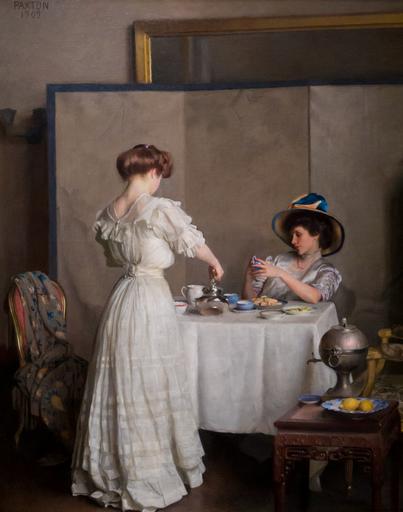MAKE A MEME
View Large Image

| View Original: | Tea_Leaves.jpg (2874x3650) | |||
| Download: | Original | Medium | Small | Thumb |
| Courtesy of: | www.flickr.com | More Like This | ||
| Keywords: painting fine art indoor William McGregor Paxton (American, Baltimore, Maryland 1869–1941 Boston, Massachusetts ) 1909, Oil on canvas 36 1/8 x 28 3/4 in. (91.6 x 71.9 cm) In a windowless parlor permeated by soft light, a dreamy atmosphere, and the sounds of silence, two elegant women pass the time by doing very little or nothing at all. Paxton hints at a narrative, but he asks that the viewer invent it, recapitulating the ambiguity of Vermeer's paintings, which he admired. Paxton often depicted refined women—like his patrons' wives and daughters—at leisure in handsome Boston interiors of the sort that they, as keepers of culture, would have decorated and occupied. By equating women with the precious aesthetic objects that surround them, Paxton echoes the spirit of the novelist Henry James, who portrayed women as collectible objects in The American (1877) and Portrait of a Lady (1881). Paxton's works also accord with pronouncements by the sociologist Thorstein Veblen, who observed in his Theory of the Leisure Class (1899) that a woman's "conspicuous leisure" signaled the wealth of her father or husband. Photographed at The Met June 2016. William McGregor Paxton (American, Baltimore, Maryland 1869–1941 Boston, Massachusetts ) 1909, Oil on canvas 36 1/8 x 28 3/4 in. (91.6 x 71.9 cm) In a windowless parlor permeated by soft light, a dreamy atmosphere, and the sounds of silence, two elegant women pass the time by doing very little or nothing at all. Paxton hints at a narrative, but he asks that the viewer invent it, recapitulating the ambiguity of Vermeer's paintings, which he admired. Paxton often depicted refined women—like his patrons' wives and daughters—at leisure in handsome Boston interiors of the sort that they, as keepers of culture, would have decorated and occupied. By equating women with the precious aesthetic objects that surround them, Paxton echoes the spirit of the novelist Henry James, who portrayed women as collectible objects in The American (1877) and Portrait of a Lady (1881). Paxton's works also accord with pronouncements by the sociologist Thorstein Veblen, who observed in his Theory of the Leisure Class (1899) that a woman's "conspicuous leisure" signaled the wealth of her father or husband. Photographed at The Met June 2016. | ||||